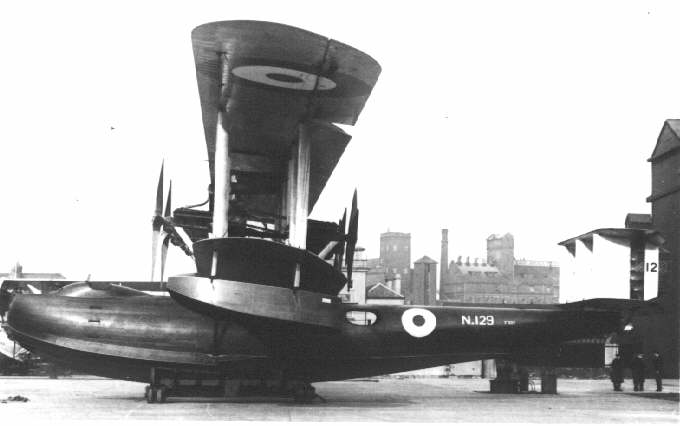Fairey N.4 on:
[Wikipedia]
[Google]
[Amazon]
The Fairey N.4 was a 1920s


An artist's impression
{{Fairey aircraft 1920s British military reconnaissance aircraft Flying boats N.4 Four-engined push-pull aircraft Biplanes Aircraft first flown in 1923
British
British may refer to:
Peoples, culture, and language
* British people, nationals or natives of the United Kingdom, British Overseas Territories, and Crown Dependencies.
** Britishness, the British identity and common culture
* British English, ...
five-seat long range reconnaissance flying boat. Designed and built by the Fairey Aviation Company
The Fairey Aviation Company Limited was a British aircraft manufacturer of the first half of the 20th century based in Hayes in Middlesex and Heaton Chapel and RAF Ringway in Cheshire. Notable for the design of a number of important military a ...
to meet an Admiralty
Admiralty most often refers to:
*Admiralty, Hong Kong
*Admiralty (United Kingdom), military department in command of the Royal Navy from 1707 to 1964
*The rank of admiral
*Admiralty law
Admiralty can also refer to:
Buildings
* Admiralty, Traf ...
requirement for a very large four-engined reconnaissance aircraft, it was the world's biggest flying boat when it first flew in 1923.Orbis 1985, p. 1716
Development
Following an increase in experience with flying boats in 1917 the Admiralty issued Specification N.4. The specification called for a four-engined long-range reconnaissance flying boat. The Admiralty ordered two aircraft from Fairey and one from Phoenix Dynamo Manufacturing Company. Fairey sub-contracted the building of the second to Dick, Kerr & Co. of Lytham St. Annes. Not unusual for the era, the design was a biplane, with the engines mounted as two push-pull pairs between the upper and lower wing, each driving a four-bladed propeller. The first N.4 (named ''Atalanta'') was that assembled by Phoenix Dynamo with a hull designed byCharles Nicholson
Sir Charles Nicholson, 1st Baronet (23 November 1808 – 8 November 1903) was an English-Australian politician, university founder, explorer, pastoralist, antiquarian and philanthropist. The Nicholson Museum at the University of Sydney is nam ...
, built by the Gosport Aircraft Company
The Gosport Aircraft Company was a short-lived British aircraft manufacturer based at Gosport, Hampshire formed at the start of the First World War by Sir Charles Allom of White, Allom & Company and Charles Ernest Nicholson of Camper and Nicho ...
was also transported to the Isle of Grain, but never flown and scrapped as the service lost interest in large flying boats. During April 1919 when the hull was complete, ''Flight'' reported the aircraft would be even larger than the Felixstowe Fury
The Felixstowe F.4 Fury ( serial ''N123''), also known as the Porte Super-Baby, was a large British, five-engined triplane flying-boat designed by John Cyril Porte at the Seaplane Experimental Station, Felixstowe, inspired by the Wanamaker Tr ...
.
The second N.4 (also named ''Atalanta'') completed in 1921, first flew on 4 July 1923 powered by four 650 hp (485 kW) Rolls-Royce Condor IA
The Rolls-Royce Condor aircraft piston engine was a larger version of the Rolls-Royce Eagle developing up to 675 horsepower (500 kW). The engine first ran in 1918 and a total of 327 engines were recorded as being built.
Variants
''Note:'' ...
piston engines. The hull built in Hythe
Hythe, from Anglo-Saxon ''hȳð'', may refer to a landing-place, port or haven, either as an element in a toponym, such as Rotherhithe in London, or to:
Places Australia
* Hythe, Tasmania
Canada
*Hythe, Alberta, a village in Canada
England
* T ...
by May, Harden & May and delivered to Lytham St. Annes for assembly. The complete aircraft was then dismantled, taken by road to the Isle of Grain
Isle of Grain (Old English ''Greon'', meaning gravel) is a village and the easternmost point of the Hoo Peninsula within the district of Medway in Kent, south-east England. No longer an island and now forming part of the peninsula, the area i ...
and stored before for its first flight.
The third N.4 Mk.II (named ''Titania'') included improvements and later variant Condor III engines. The hull designed by Linton Hope
Linton Chorley Hope FRAes (18 April 1863 – 20 December 1920) was a sailor from Great Britain, who represented his country at the 1900 Summer Olympics in Meulan, France. With Lorne Currie as helmsman and fellow crewmembers John Gretton and A ...
, built on the Clyde Clyde may refer to:
People
* Clyde (given name)
* Clyde (surname)
Places
For townships see also Clyde Township
Australia
* Clyde, New South Wales
* Clyde, Victoria
* Clyde River, New South Wales
Canada
* Clyde, Alberta
* Clyde, Ontario, a tow ...
by yacht builders Fyffes and delivered to The Fairey Aviation Company at Hamble Hamble may refer to:
* The River Hamble in Hampshire, England
* Hamble aerodrome on the banks of the River Hamble.
** Hamble-Warsash Ferry, a ferry service on the River Hamble
* Hamble-le-Rice, a village on the river Hamble, close to the city of Sou ...
, Southampton for assembly and transport to the Isle of Grain. ''Titania'' was not flown straight away and stored, first flying on 24 July 1925.
Specifications (Mk II ''Titania'')


See also
References
Notes
Bibliography
*External links
An artist's impression
{{Fairey aircraft 1920s British military reconnaissance aircraft Flying boats N.4 Four-engined push-pull aircraft Biplanes Aircraft first flown in 1923